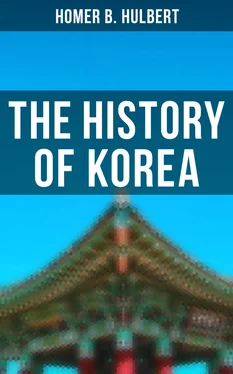The king’s directions were carried out and his son, Chong-myŭng, burned his body on a great stone by the Eastern Sea and gave the stone the name “Great King Stone.” That the Emperor granted investiture to this new king shows that all the troubles had been smoothed over. But from this time on Chinese interest in the Korean peninsula seems to have died out altogether. The little kingdom of Latter Ko-gu-ryŭ, which the Emperor had established on the border, no sooner got on a sound basis than it revolted and the Emperor had to stamp it out and banish its king to a distant Chinese province. This, according to the records, was the “last” end of Ko-gu-ryŭ. It occurred in 682 A.D.
Sil-la now held all the land south of the Ta-dong River. North of that the country was nominally under Chinese control but more likely was without special government. In 685 Sil-la took in hand the redistribution of the land and the formation of provinces and prefectures for the purpose of consolidating her power throughout the peninsula. She divided the territory into nine provinces, making three of the original Păk-je and three of that portion of the original Ko-gu-ryŭ that had fallen into her hands. The three provinces corresponding to the original Sil-la were (1) Sŭ-bŭl-ju (the first step in the transformation of the word Sŭ ya-bŭl to Seoul), (2) Sam-yang-ju, now Yang-san, (3) Ch‘ŭng-ju now Chin-ju. Those comprising the original Păk-je were (1) Ung-ch‘ŭn-ju in thenorth, (2) Wan-san-ju in the south-west, (3) Mu-jin-ju in the south, now Kwang-ju. Of that portion of Ko-gu-ryŭ which Sil-la had acquired she made the three provinces (1) Han-san-ju, now Seoul, (2) Mok-yak-ju, now Ch‘un-ch‘ŭn, (3) Ha-să-ju, now Kang-neung. These nine names represent rather the provincial capitals than the provinces themselves. Besides these important centers there were 450 prefectures. Changes followed each other in quick succession. Former Ko-gu-ryŭ officials were given places of trust and honor; the former mode of salarying officials, by giving them tracts of land from whose produce they obtained their emoluments, was changed, and each received an allowance of rice according to his grade; the administration of the state was put on a solid basis.
One of the most far-reaching and important events of this reign was the invention of the yi-du , or set of terminations used in the margin of Chinese texts to aid the reader in Koreanizing the syntax of the Chinese sentence. We must bear in mind that in those days reading was as rare an accomplishment in Sil-la as it was in England in the days of Chaucer. All writing was done by the a-jun , who was the exact counterpart of the “clerk” of the Middle Ages. The difficulty of construing the Chinese sentence and using the right suffixes was so great that Sŭl-ch‘ong, the son of the king’s favorite monk, Wŭn-hyo, attempted a solution of the difficulty. Making a list of the endings in common use in the vernacular of Sil-la he found Chinese characters to correspond with the sounds of these endings. The correspondence was of two kinds; either the name of the Chinese character was the same as the Sil-la ending or the Sil-la meaning of the character was the same as the ending. To illustrate this let us take the case of the ending sal-ji , as in ha-sal-ji , which has since been shortened to ha-ji . Now, in a Chinese text nothing but the root idea of the word ha will be given and the reader must supply the sal-ji which is the ending. If then some arbitrary signs could be made to represent these endings and could be put in the margin it would simplify the reading of Chinese in no small degree. It was done in this way:There is a Chinese character which the Koreans call păk , Chinese pa , meaning “white.” One of the Sil-la definitions of this character sal-wi-ta . It was the first syllable of this word that was used to represent the first syllable of the ending sal-ji . Notice that it was not the name of the character that was used but the Sil-la equivalent. For the last syllable of the ending sal-ji , however, the Chinese character ji is used without reference to its Sil-la equivalent. We find then in the yi-du as handed down from father to son by the a-jun’s of Korea a means for discovering the connection between the Korean vernacular of to-day with that of the Sil-la people. It was indeed a clumsy method, but the genius of Sŭl-ch‘ong lay in his discovery of the need of such a system and of the possibility of making one. It was a literary event of the greatest significance. It was the first outcry against the absurd primitiveness of the Chinese ideography, a plea for common sense. It was the first of three great protests which Korea has made against the use of the Chinese character. The other two will be examined as they come up. This set of endings which Sŭl-ch‘ong invented became stereotyped and through all the changes which the vernacular has passed the yi-du remains to-day what it was twelve hundred years ago. Its quaint sounds are to the Korean precisely what the stereotyped clerkly terms of England are to us, as illustrated in such legal terms as to wit , escheat and the like. There is an important corollary to this fact. The invention of the yi-du indicates that the study of Chinese was progressing in the peninsula and this system was invented to supply a popular demand. It was in the interests of general education and as such marks an era in the literary life of the Korean people. The name of Sŭl-ch‘ong is one of the most honored in the list of Korean literary men.
The eighth century opened with the beginning of a new and important reign for Sil-la. Sŭng-dŭk came to the throne in 702 and was destined to hold the reins of power for thirty-five years. From the first, his relations with China were pleasant. He received envoys from Japan and returned the compliment, and his representatives were everywhere well received. The twelfth year of his reign beheld the founding of the kingdom of Pal-hă in the north. This was an event of great significance to Sil-la. The Song-mal family of the Mal-gal group of tribes, under the leadership of Kŭl-gŭl Chung-sŭng, moved southward into the peninsula and settled near the original Tă-băk Mountain, now Myo-hyang San. There they gathered together many of the Ko-gu-ryŭ people and founded a kingdom which they called Chin. It is said this kingdom was 5,000 li in circumference and that it contained 200,000 houses. The remnants of the Pu-yŭ and Ok-jŭ tribes joined them and a formidable kingdom arose under the skillful management ofKŭl-gŭl Chung-sŭng. He sent his son to China as a hostage and received imperial recognition and the title of King of Pal-hă. From that time the word Mal-gal disappears from Korean history and Pal-hă takes its place.
During the next few years Sil-la made steady advance in civilization of the Chinese type. She imported from China pictures of Confucius and paid increased attention to that cult. The water clock was introduced, the title Hu was given to the Queen, the custom of approaching the throne by means of the sang-so or “memorial” was introduced.
Meanwhile the kingdom of Pal-hă was rapidly spreading abroad its arms and grasping at everything in sight. China began to grow uneasy on this account and we find that in 734 a Sil-la general, Kim Yun-jung went to China and joined a Chinese expedition against the Pal-hă forces. The latter had not only absorbed much territory in the north but had dared to throw troops across the Yellow Sea and had gained a foothold on the Shantung promontory. This attempt to chastise her failed because the season was so far advanced that the approach of winter interfered with the progress of the campaign.
Читать дальше









